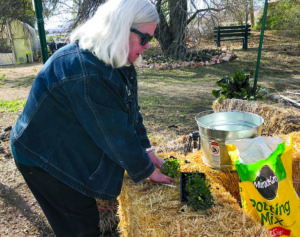By GRACIE LEAVITT
Moapa Valley Progress

A small group of Moapa Valley gathered on Saturday, Feb. 15 at the Cooperative Extension building in Logandale to learn about the technique of straw bail gardening.
Instructors were Dr. James Rimpau and Peggy Raines, both of which have had years of farming experience. Rimpau is the president of the community garden in Mesquite and commented that he has participated in straw bale gardening for a few years now.
Raines, a Logandale resident, works for the Cooperative Extension. She too has made the convenient change from box gardening to straw bale gardening.
“I started because when I first moved to the valley it was all sand and gravel,” Rames said.
Raines said that she later put down soil, but had hopes of trying something different with the new environment. So she tried using straw bale gardening.
Participants at the workshop were provided with a planting schedule for most commonly grown crops.
A presentation explained the basics of Straw bale gardening. It was explained that straw differs from hay in gardening purposes. Using barley straw or wheat straw for gardening was explained to have tremendous benefits and conveniences when compared with the customary soil garden box.
Straw bale gardening is also considered organic. But normal problems such as bugs and viruses are less likely to take place in the straw. Even mammals such as rabbits tend to keep out of the straw bale garden.
Straw bales can be started earlier in the season because the condensed plant is able to hold more heat. In addition, it is impossible to over-water the crops being grown because all of the excess water escapes to the bottom of the straw bale.
In addition, no crop rotation is necessary with this method.
“Any raised bed has the advantage as you get older, that you don’t have to bend over,” Raines said. “However, the straw bales are more weed free and water smart and when they’re done there is compost to use for trees and other plants.”
A few warnings were given on how to be more efficient and successful when gardening this way. One was to not use dirt or any labeled soil. The best way for all of the crops to receive shade was having them face North to South and have the “cut side” facing up. This way the straw can better soak up water and receive the vital nutrients-when placed in rows.
The best place to find straw bales for gardening is at a farm or plant nursery. Dr. Rimpau emphasized that staw can be difficult to find in Moapa Valley. He suggested that gardeners go to Utah to obtain real straw. He said that it was worth the trip.
The participants then went outside to get some hands-on instruction. The instructors went to a newly laid garden and showed how to place a potted plant and seeds. They showed how to properly water and placed the landscape fabric over them.
Lastly they discussed what decomposed straw looks like and it’s properties, this is the sign of a healthy garden.
“It won’t look like anything is happening,” said Dr. Rimpau, “but the bacteria is digesting the straw and making nitrogen.”
Participants were given the chance to ask questions and learn in various ways.










